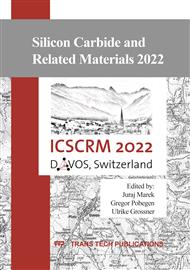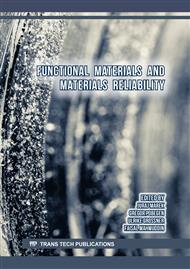[1]
B. Kostka, D. Herwig, M. Hanf, C. Zorn, and A. Mertens, "A concept for detection of humidity- driven degradation of igbt modules," IEEE Transactions on Power Electronics, vol. 36, no. 12, pp.13-355–13 359, 2021.
DOI: 10.1109/tpel.2021.3090149
Google Scholar
[2]
M. Mermet-Guyennet and M. Piton, "Railway traction reliability," in 2010 6th International Conference on Integrated Power Electronics Systems, 2010.
Google Scholar
[3]
T. Barbieri, A. Barkley, E. Ayerbe, Z. Major, M. Tauer, J. Young, and D. Gajewski, "Reliability Testing of SiC JBS Diodes for Harsh Environment Operation," in PCIM Europe 2018; Interna- tional Exhibition and Conference for Power Electronics, Intelligent Motion, Renewable Energy and Energy Management, 2018.
Google Scholar
[4]
F. Hoffmann, S. Schmitt, and N. Kaminski, "Comparison of the h3trb performance of silicon and silicon carbide power modules," Materials Science Forum, vol. 1062, p.487–492, 2022.
DOI: 10.4028/p-7j50kd
Google Scholar
[5]
C. Herold, J. Sun, P. Seidel, L. Tinschert, and J. Lutz, "Power Cycling Methods for SiC MOS- FETs," in 2017 29th International Symposium on Power Semiconductor Devices and IC's (ISPSD), 2017, p.367–370.
DOI: 10.23919/ispsd.2017.7988994
Google Scholar
[6]
F. Hoffmann, N. Kaminski, and S. Schmitt, "Comparison of the power cycling performance of silicon and silicon carbide power devices in a baseplate less module package at different temper- ature swings," in 2021 33rd International Symposium on Power Semiconductor Devices and ICs (ISPSD), 2021, p.175–178.
DOI: 10.23919/ispsd50666.2021.9452242
Google Scholar
[7]
N. Soltau, E. Wiesner, E. Stumpf, S. Idaka, and K. Hatori, "Electric-energy savings using 3.3 kv full-sic power-modules in traction applications," in 2020 Fifteenth International Conference on Ecological Vehicles and Renewable Energies (EVER), 2020.
DOI: 10.1109/ever48776.2020.9242996
Google Scholar
[8]
A. Hussein and A. Castellazzi, "Comprehensive design optimization of a wind power converter using sic technology," in 2018 International Conference on Smart Grid (icSmartGrid), 2018, p.34–38.
DOI: 10.1109/isgwcp.2018.8634431
Google Scholar
[9]
N. Kaminski, S. Rugen, and F. Hoffmann, "Gaining confidence - a review of silicon carbide's reliability status," in 2019 IEEE International Reliability Physics Symposium (IRPS), 2019.
DOI: 10.1109/irps.2019.8720578
Google Scholar
[10]
F. Hoffmann, N. Kaminski, and S. Schmitt, "Investigation on the impact of environmental stress on the thermo-mechanical reliability of igbts by means of consecutive h3trb and pct testing," in 2021 33rd International Symposium on Power Semiconductor Devices and ICs (ISPSD), 2021, p.371–374.
DOI: 10.23919/ispsd50666.2021.9452227
Google Scholar
[11]
C. Zorn and N. Kaminski, "Temperature humidity bias testing on insulated-gate bipolartransistor modules – failure modes and acceleration due to high voltage," IET Power Electronics, vol. 8, no. 12, p.2329–2335, 2015.
DOI: 10.1049/iet-pel.2015.0031
Google Scholar
[12]
J.-H. Peters, M. Hanf, S. Clausner, C. Zorn, and N. Kaminski, "Improved hv-h³trb robustness of a 1700 v igbt chip set in standard power modules," Microelectronics Reliability, vol. 126, p.114211, 2021, proceedings of ESREF 2021, 32nd European Symposium on Reliability of Elec- tron Devices, Failure Physics and Analysis.
DOI: 10.1016/j.microrel.2021.114211
Google Scholar
[13]
C. Herold, M. Schaefer, F. Sauerland, T. Poller, J. Lutz, and O. Schilling, "Power cycling capa- bility of modules with SiC-diodes," in CIPS 2014; 8th International Conference on Integrated Power Electronics Systems, 2014.
Google Scholar
[14]
F. Hoffmann and N. Kaminski, "Power cycling performance and lifetime estimation of 1700v sic mps diode modules with multiple chips connected in parallel," in 2020 32nd International Symposium on Power Semiconductor Devices and ICs (ISPSD), 2020, p.537–540.
DOI: 10.1109/ispsd46842.2020.9170187
Google Scholar



